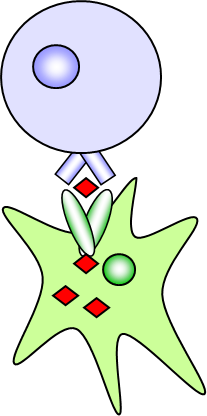Our team is working on the prediction and the mechanisms of the immunogenicity of therapeutic proteins and peptide vaccines in humans. Immunogenicity is the ability of molecules to induce an immune response. It is a major problem for the development of therapeutic proteins and a necessity for peptide vaccines.
Team Leader
Bernard Maillère
bernard.maillère@cea.fr
Predicting immunogenicity of therapeutic proteins
Therapeutic proteins since 1995 represent a third of the products placed on the market and have a greater development growth than organic molecules. They have many advantages including specificity but have the risk of immunogenicity is to say, the risk of eliciting an immune response. Antibodies against a therapeutic protein may decrease or increase its pharmacokinetics, neutralize its therapeutic activity or trigger autoimmune symptoms. Because of the major role of CD4 T cells in the initiation and regulation of immune response, the main means of prediction based on the quantification of the specific directory in naïve CD4 T and the identification of the corresponding CD4 epitopes. The current work focuses on therapeutic antibodies Infliximab, Rituximab and Adalimumab Natalizumab and proteins such as beta interferon and factor VIII. These data are compared to those obtained in patients who have developed resistance to these therapeutic molecules. Effector phenotype or control specific CD4 T cells of therapeutic proteins is also wanted. We are studying the possibility of  creating de-immune molecules that is to say, not inducing an immune response.
creating de-immune molecules that is to say, not inducing an immune response.
CD4 T cells have a rearranged receptor that recognizes antigens as peptides presented by HLA class II molecules. These peptides (T epitopes) are derived from the degradation of the antigens into dendritic cells and have a sequence allowing them to bind to HLA class II molecules.
T cells are selected in the thymus vis-à-vis self peptides but this selection is not complete so that the sequences of human origin can be recognized by CD4 T cells and trigger an immune response.
The T cell response to tumor antigens
Since tumor antigens were discovered, many clinical trials attempt to induce a cellular immune response that selectively targets tumor cells and spare the normal cells. Many efforts are made to find the target antigens may be included in an anti-cancer vaccine and to characterize their epitopes T. However, the observed responses are often inadequate and fail to recruit enough CD4 and CD8 T cells to eliminate tumors.
We have studied many tumor antigens for their ability to induce CD4 and CD8 responses; we especially evaluated the  response of Survivin and midkine antigens and recently cyclin B1.Our goal is to combine the CD4 and CD8 T-cell epitopes to define long fragments can be used as therapeutic vaccines against tumors. A vaccine based on T epitopes we discovered is being developed by the company Vaxeal (Vaxeal Research, Genopôle Evry).
response of Survivin and midkine antigens and recently cyclin B1.Our goal is to combine the CD4 and CD8 T-cell epitopes to define long fragments can be used as therapeutic vaccines against tumors. A vaccine based on T epitopes we discovered is being developed by the company Vaxeal (Vaxeal Research, Genopôle Evry).
T epitopes search in pathogens and allergens
The CD4 and CD8 T cells play a major role in controlling chronic infections such as HIV infection. The identification of epitopes T turns out to be very useful in the design of synthetic vaccines against these agents insofar as their immunogenicity is high. We have in particular shown that the amplitude responses in T cell epitopes different depends on the size of the specific naive repertoire of these peptides.
The identification of epitopes T is also useful for monitoring the immunological response of vaccinated or infected patients. We participate in several epitopes of localization projects including assessing the affinity of peptides to HLA molecules.
Class II HLA molecules are highly polymorphic in other words vary from one individual to another. Because of this polymorphism, T epitopes may be different from one individual to another.
Structure de la molécule HLA-DR1 (vert) et d’un peptide antigénique (rouge)
We have specific binding assays for HLA class II molecules (most common in the Caucasian population, Europe, USA). Our collection includes molecules HLA-DR molecules, -DQ and -DP.
The tests are fully robotized and based on an ELISA principle in competition with biotinylated peptides.
Test de liaison aux molécules HLA de classe II